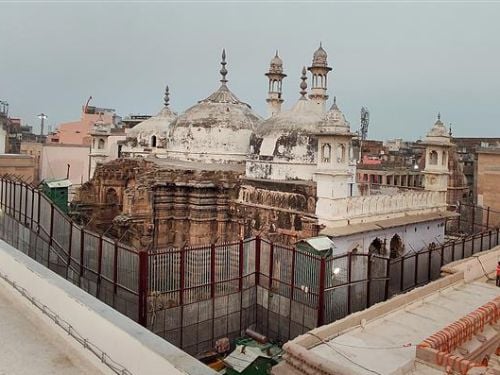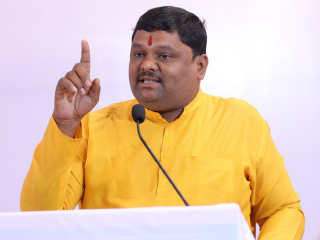
In a big victory for Hindus, the district court of Varanasi ruled on Wednesday (31st January) that the Hindus have the right to worship in the Vyas cellar of the Gyanvapi structure. The court has ordered the district administration to make arrangements for worship at the basement within 7 days. This cellar is below the so-called mosque inside the structure. Now regular worship rituals will take place here as per the court’s order. The puja will be performed by the Kashi Vishwanath Trust Board.
The district judge had reserved the order on 30th January after hearing a petition filed by Shailendra Kumar Pathak seeking the right to recite prayers and perform worship rituals at the Vyas Ji Ka Tehkhana (the basement cellar of the Vyas family) located in Varanasi’s Gyanvapi complex. The decision in this case has come today.
District Judge Justice Ajay Krishna Vishvesh said in his order, “The District Magistrate, Varanasi is directed to get the priest to perform the puja, raga-blog, of the idols located in the basement in the basement – which is the suit property, as designated by the plaintiff and the Kashi Vishwanath Trust Board. For this purpose, make proper arrangements in iron fences etc. within 7 days. The respondent has applied. The letter for disposal of this application should be submitted on 08.02.2004. In the meantime, the plaintiff party can raise objections.” A copy of this order is with OpIndia.
The Vyas Ji Ka Tehkhana is one of the four basement chambers at the Gyanvapi complex, which is managed by the Vyas family. As per the family, they have a long history of association with the temple since 1551.
In 1991, the Vyas family filed a case seeking the transfer of the Gyanvapi mosque structure to Hindus. They asserted that, except for the upper structure dedicated to namaz and the domes, the entire structure still belongs to the Lord Visheshwar temple. Even though the Vyas family no longer resides in the Kashi Vishwanath-Gyanvapi complex, they still retain ownership of one of the four basements of the mosque.
After the petition was filed by the family, the Muslim side had sought the dismissal of the same citing the Place of Worship Act. The court has now rejected the argument of the Muslim side and has given the Hindu side the right to worship in the Vyas cellar of Gyanvapi.
Advocate Vishnu Shankar Jain, representing the Hindu side in the Gyanvapi case, said that the administration has been asked to make arrangements for worship by Hindus within 7 days, and puja will start soon. He added that as soon as arrangements are made by the administration, worship will start immediately. He said that the court rectified a wrong decision by the govt to stop the worship. He claimed that there was never any written order to stop puja, and it was done base only on oral orders of the govt.
#WATCH | Advocate Vishnu Shankar Jain, representing the Hindu side says, "…Puja will start within seven days. Everyone will have the right to perform Puja…" pic.twitter.com/EH27vQQJdc
— ANI (@ANI) January 31, 2024
It is notable that on 25th January, the report by the Archaeological Survey of India (ASI) report on the Gyanvapi Masjid was made public. It revealed the existence of a large Hindu temple structure underneath the disputed structure.
The petitioner Shailesh Kumar Pathak ‘Vyas’ has earlier said, “Vyas family has a history of association with the Kashi Vishwanath Temple (KVT) since 1551. It had started living in this complex in 1883. My ancestors not only contested different cases with the mosque authorities since 1880 but also filed the first petition in the Varanasi civil court in 1991, seeking permission for worship at Gyanvapi.”
Telling about the basement under the possession of the Vyas family, he had said, “This ‘tehkhana’ (basement) is in the southern part of the Gyanvapi mosque located in front of the face of Nandi (in Kashi Vishwanath Dham). We used to call this portion ‘garbhgriha’ (sanctum sanctorum) of the old Visheshwar temple. Goddess Shringar Gauri’s idol was worshipped there till December 5, 1992, a day before the Babri masjid demolition.”
He added, “Since December 6, 1992, the regular worship was stopped there. The basement was under the possession of our family and we were allowed to use it to keep articles related to Ramayan recitals like wooden poles, ‘kanats’ etc. The recital used to take place twice every year in Magh and Kartik. The Vyas family was allowed to offer prayer at Shringar Gauri on the fourth day of Chaitra Navratri.”
Source: OpIndia





